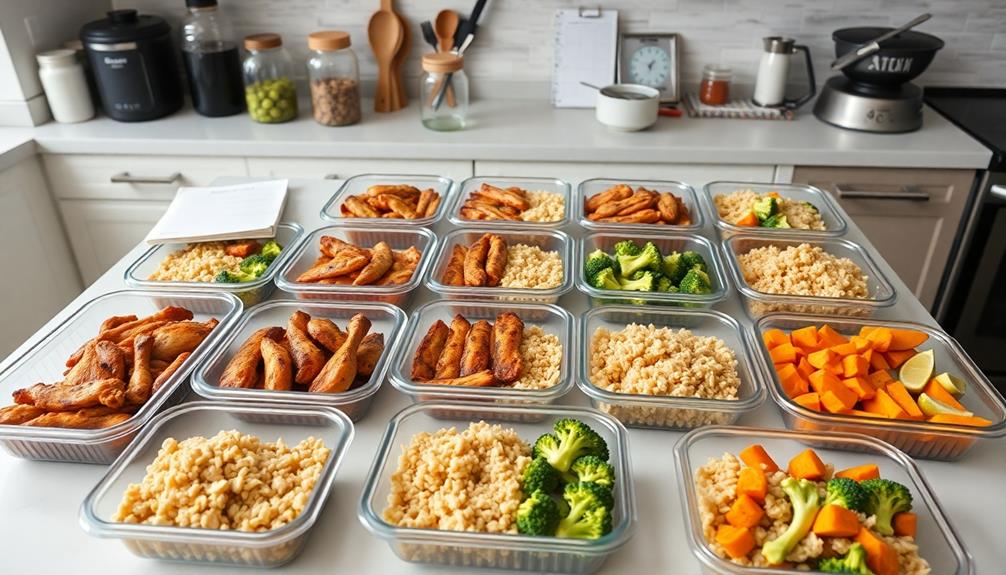To start meal prepping for bulking, calculate your caloric needs based on your BMR and activity level. Plan a weekly menu with balanced meals, including proteins, complex carbs, and healthy fats. Create a detailed grocery list and shop for ingredients, focusing on lean meats, whole grains, fruits, and vegetables. Prep and cook your meals in bulk, using various cooking methods for variety. Portion your meals into containers, labeling them with contents and dates. Store meals properly in the refrigerator or freezer. Stay consistent with your meal plan and adjust as needed based on your progress. This step-by-step approach will set you up for successful bulking.
Core Insight
- Calculate your caloric needs based on BMR, activity level, and desired bulk rate.
- Plan a weekly menu with balanced meals including proteins, complex carbs, and healthy fats.
- Create a detailed grocery list categorized by food groups and buy ingredients in bulk when possible.
- Prepare meals in large batches using various cooking methods for variety and flavor.
- Portion meals accurately, store in labeled containers, and organize for efficient refrigeration or freezing.
Calculate Your Caloric Needs
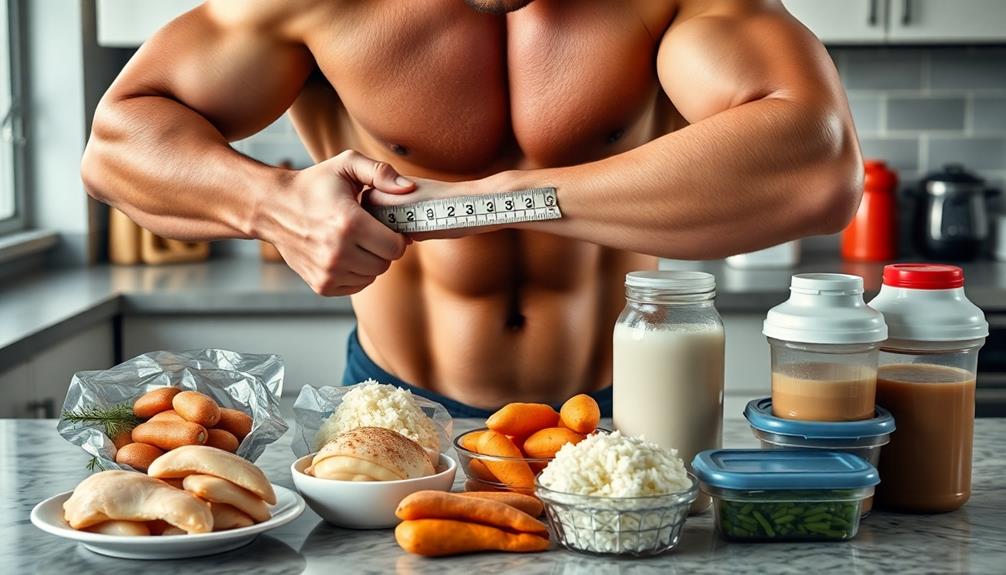
To bulk up, you first need to know how many calories your body needs each day. Find an online calculator or use a formula to figure out your basal metabolic rate (BMR). This is based on things like your age, height, weight, and gender. Then, think about how active you are to find your total daily energy expenditure (TDEE).
When bulking, you should eat more calories than your TDEE. For a moderate bulk, add 300-500 calories. If you want to bulk up faster, add 500-1000 calories. These are just general tips, so you might need to change things based on how your body responds.
Keep an eye on your progress by checking your weight and measurements each week. If you're not gaining weight, slowly increase how many calories you're eating. Stick with it, and you'll see results.
Plan Your Weekly Menu
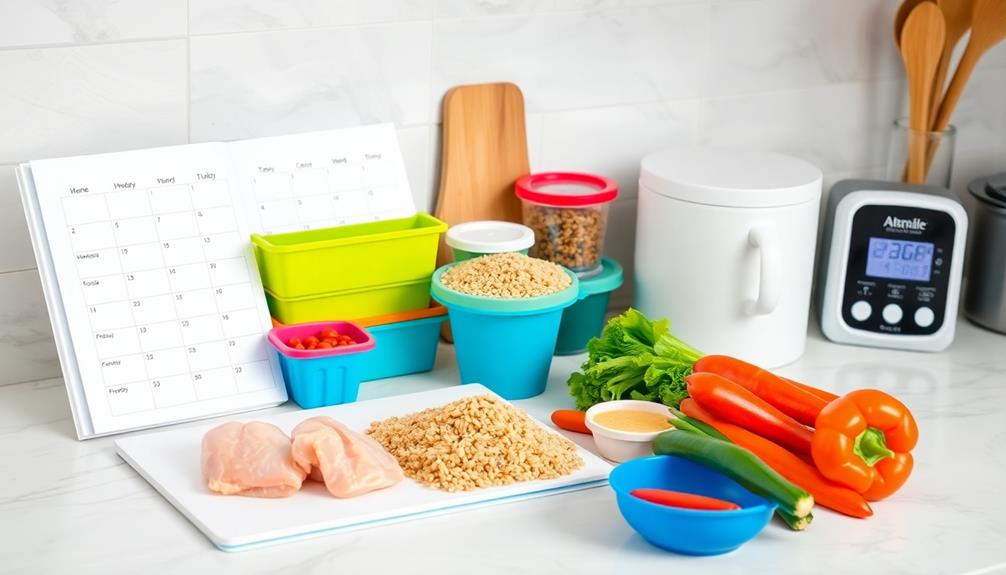
Planning your weekly menu is the next step after calculating your calorie needs. Choose a range of proteins, complex carbs, and healthy fats to reach your macro goals. Include foods like lean meats, fish, eggs, whole grains, fruits, veggies, and nuts. Low-carb protein shakes are a handy way to up your protein while keeping carbs low.
Make a balanced menu for each day, hitting your calorie and macro targets. Mix up flavors and textures to keep meals interesting. Choose recipes that fit your schedule and can be prepped ahead.
Shoot for 3-4 main meals and 1-2 snacks per day, with pre- and post-workout meals if needed. Create a detailed grocery list from your menu to simplify shopping. Don't forget to plan for any dietary restrictions or preferences.
Create a Grocery List
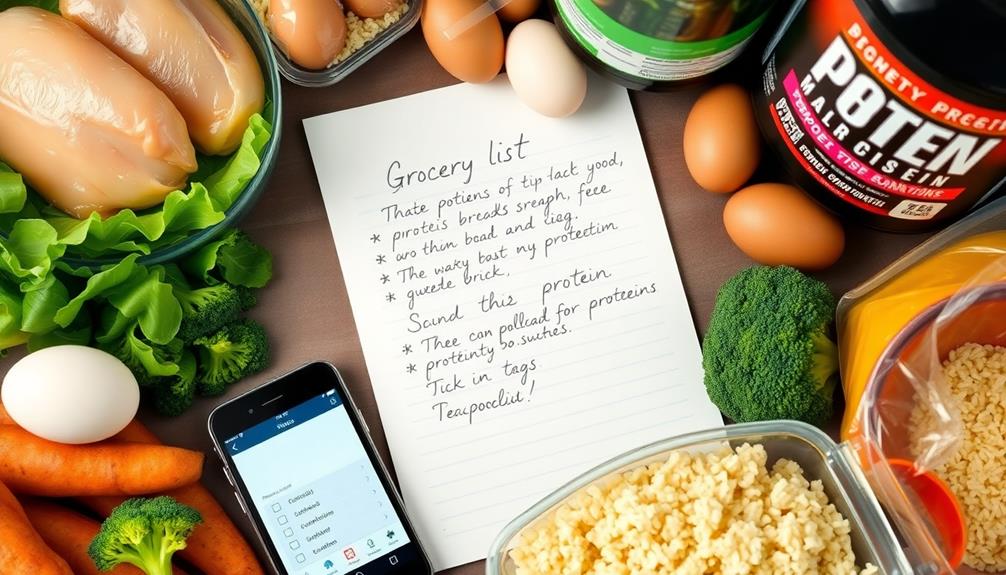
To make a grocery list, start by looking over your meal plan and writing down all the ingredients you need. Check what you already have at home so you don't buy extras. If you're trying to bulk up, think about adding vegan pre-workout supplements to your list.
Break your list into sections:
- Protein foods like meat, fish, eggs, and dairy
- Carbs such as grains, pasta, and bread
- Fruits and veggies
- Healthy fats from oils, nuts, and avocados
- Spices and sauces
Figure out how much of each item you need based on your recipes and how many servings you want. Buying in bulk can save money on things that last a long time. Add any supplements you take for bulking. Grab food containers if you need them to portion out your meals. A good list will help you shop faster and make sure you have everything for successful meal prep.
Shop for Ingredients
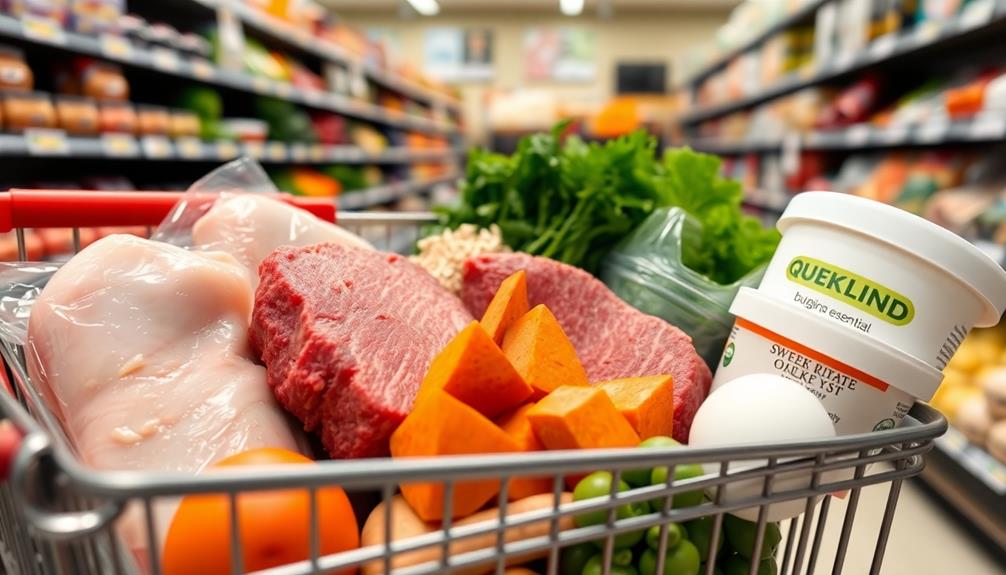
Start your grocery shopping in the produce section. Pick fresh fruits and veggies that'll last all week, like apples, bananas, and leafy greens. Then get your proteins – lean meats, fish, eggs, and plant-based options if that's your thing. If you need quick nutrition on the go, grab some meal replacement powders too.
Next up, hit the grains and legumes aisle for complex carbs like brown rice, quinoa, and oats. Don't forget beans and lentils for extra protein and fiber. Finally, swing by the dairy section for milk, yogurt, and cheese that fit your nutrition plan.
Prep and Cook in Bulk
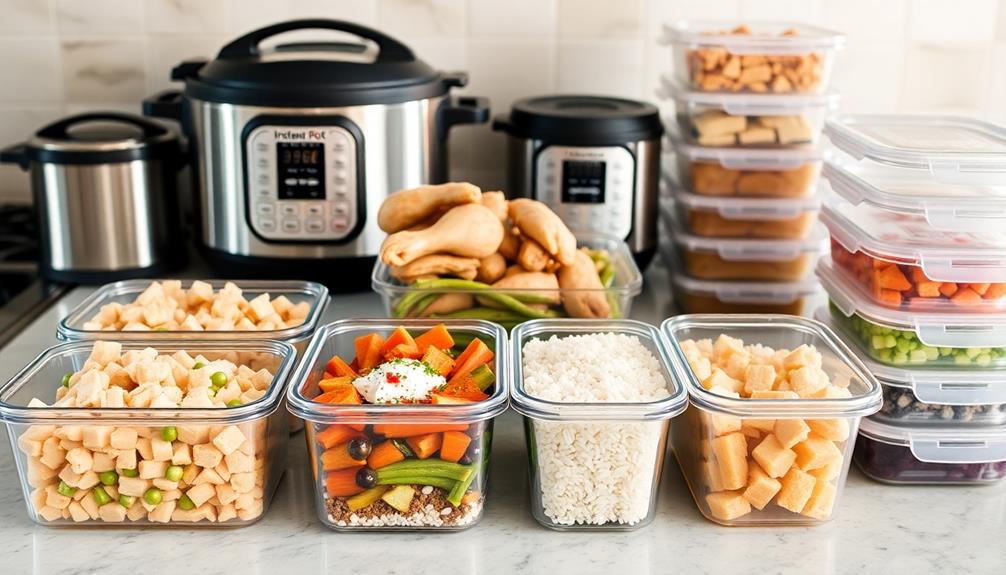
Once you've got your ingredients, it's time to start bulk cooking. First, prep your proteins, carbs, and veggies. Cook big batches of chicken, rice, and roasted vegetables at the same time to save time. Use different cooking methods to keep your meals interesting.
| Protein | Carbs | Vegetables | Cooking Method |
|---|---|---|---|
| Chicken | Rice | Broccoli | Bake/Roast |
| Beef | Potatoes | Carrots | Slow Cook |
| Fish | Pasta | Spinach | Grill |
| Tofu | Quinoa | Mixed Veg | Stir-fry |
While your food cooks, make sauces and seasonings to add flavor. Don't forget to divide your meals into containers so they're ready to grab and go during the week. Let food cool before putting it away to keep it fresh and avoid condensation. The more you bulk cook, the better you'll get at it.
Portion and Store Meals
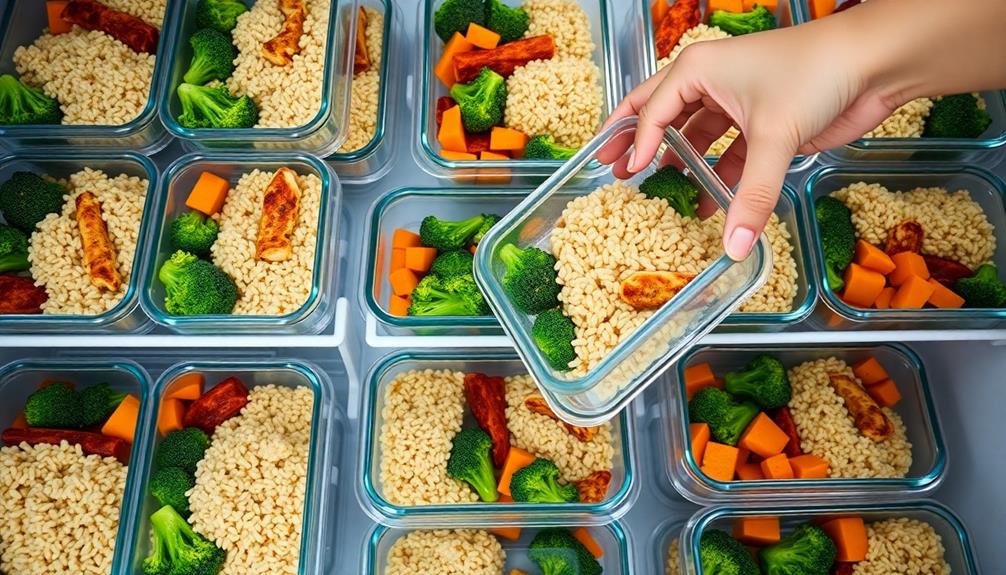
Proper portioning and storage are key for successful meal prepping. After cooking meals in bulk, divide them into individual servings. Use a food scale for accurate portions that match your bulking goals. Use high-quality, microwave-safe containers with airtight lids to keep meals fresh. Focus on recovery between workouts to support muscle growth while following your bulking diet.
Label each container with the meal and date prepared. This helps track freshness and keep variety in your diet. Refrigerate most meals for up to 4-5 days. Freeze meals for longer storage, up to 3 months.
Store rice or pasta separately from sauces to avoid sogginess. Stack containers efficiently to save space. Eat older meals first to reduce waste.
Stay Consistent and Adjust
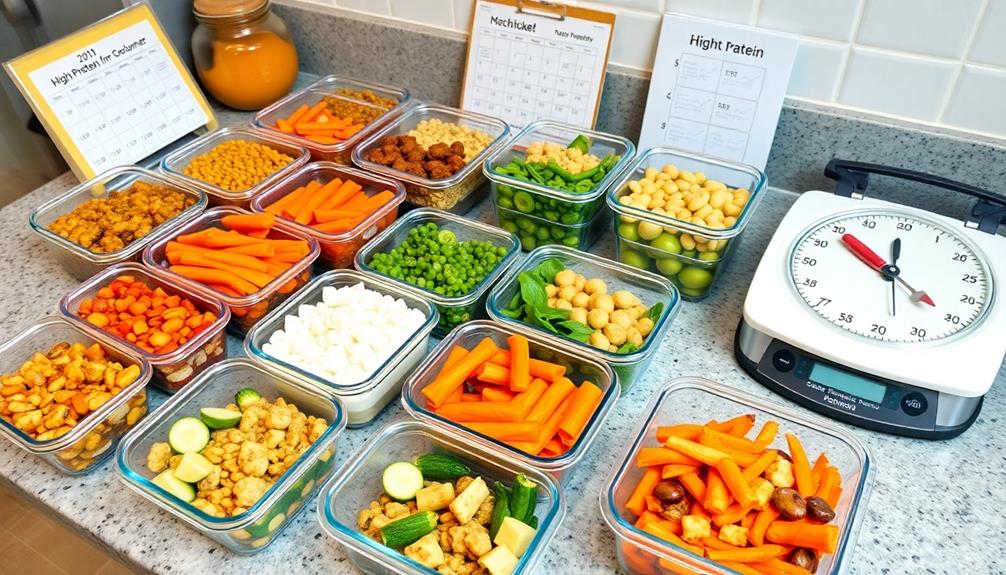
Stick with your meal prep plan to reach your bulking goals, but be ready to tweak things if needed. Keep an eye on your weight, body measurements, and strength to see if you're making progress. If you're not getting the results you want, you might need to eat more calories or change up your protein, carb, and fat balance. If you're having trouble eating enough, adding mass gainers to your meals can help you get the nutrients and calories you need.
Bulking takes time, so don't make big changes too fast. Instead, make small tweaks to your meal plan and watch what happens. Don't be afraid to try new recipes or foods to keep things interesting. If you stick with your meal prep and make smart changes when needed, you'll be able to reach your bulking goals.
Frequently Asked Questions
How Long Can Meal Prepped Food Safely Stay in the Refrigerator?
You can safely store meal prepped food in your refrigerator for 3-5 days. It's best to consume proteins within 3 days, while most vegetables and grains can last up to 5 days. Always check for signs of spoilage before eating.
Can I Freeze My Prepped Meals for Longer Storage?
Yes, you can freeze your prepped meals for longer storage. It's a great way to extend shelf life. You'll want to use freezer-safe containers and label them with dates. Just remember to thaw properly before reheating.
What Are the Best Containers for Storing Meal Prepped Food?
You'll want to use airtight, microwave-safe containers for storing meal prepped food. Glass containers are durable and don't retain odors. Plastic containers are lightweight and affordable. Choose BPA-free options with leak-proof lids for convenience and safety.
How Do I Prevent My Prepped Meals From Becoming Soggy?
To prevent soggy prepped meals, you'll want to keep wet and dry ingredients separate. Use divided containers, pack sauces separately, and let hot foods cool before sealing. Don't forget to use moisture-absorbing ingredients like rice or lettuce.
Are There Any Foods That Don't Work Well for Meal Prepping?
You'll want to avoid prepping foods that don't reheat well, like fried items or delicate greens. Soft fruits, dairy-based dishes, and crispy vegetables can also lose quality. Stick to hardy ingredients that maintain texture and flavor over time.

